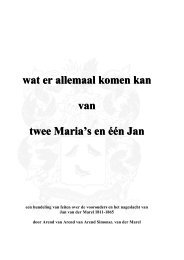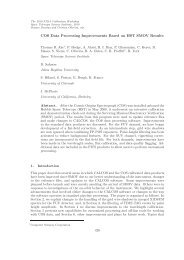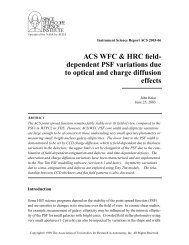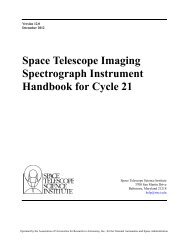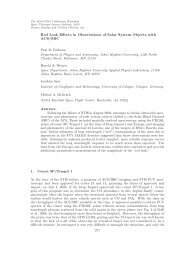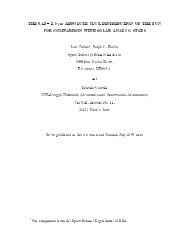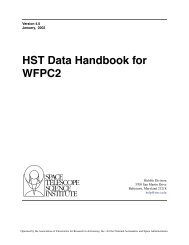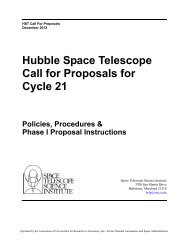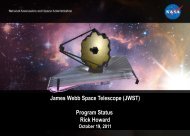STScI Annual Report 2002: A Living Mission
STScI Annual Report 2002: A Living Mission
STScI Annual Report 2002: A Living Mission
Create successful ePaper yourself
Turn your PDF publications into a flip-book with our unique Google optimized e-Paper software.
Melissa McGrath (cont’d)<br />
Project to Re-Engineer Space Telescope Observing. The HURT team spearheaded<br />
many innovations for Hubble proposal processing, including the<br />
then-new Phase I LaTeX template, the switch to visit-based observing allocations,<br />
and the birth of the RPS2—Remote Proposal Submission 2—software<br />
system. She then served, successively, as an instrument scientist for<br />
the Goddard High Resolution Spectrograph, the Space Telescope Imaging<br />
Spectrograph (leading the implementation of its data processing pipeline<br />
and on-the-fly calibration), and the Cosmic Origins Spectrograph. Before<br />
her recent move to head the Community <strong>Mission</strong>s Office, she was in the<br />
Engineering and Software Services Division, where she led several projects,<br />
including PROMPT—PRoblem Observation Management ProjecT—and the<br />
Institute’s involvement in the Kepler Discovery mission.<br />
Scientifically, Melissa's primary areas of research expertise include imaging<br />
and spectroscopic studies of the upper atmospheres and magnetospheres<br />
of the outer planets, satellite atmospheres (specifically Io, Titan, Europa,<br />
and Ganymede), and the Io plasma torus. She also has expertise in basic<br />
atomic physics cross-section calculations and in the atomic physics of sulfur<br />
and oxygen. She was one of the six principal investigators of the Hubble<br />
team that led the Comet Shoemaker-Levy 9 impact observations in 1994.<br />
Although there have been many exciting moments in her career so far, the<br />
SL9 campaign was Melissa’s experience of a lifetime. Never before nor<br />
after had so much public and press attention been focused on the Institute<br />
and Hubble. Security at the Institute was very tight during impact week,<br />
numerous TV trucks were parked at the curb in front of the building, and<br />
tension and anticipation ran very high. Several last minute predictions held<br />
that the event would be a ‘fizzle’. Nevertheless, ever optimistic, Melissa<br />
was the member of the Hubble team that purchased two bottles of champagne<br />
the day the impacts were to begin. One was opened at the last Hubble<br />
science team meeting the afternoon before the first impact, and one was<br />
saved for later. The celebration that ensued after the scar from the first<br />
impact became visible in Hubble observations was spurred on by the second<br />
bottle of champagne, and the scenes of Melissa and Heidi Hammel opening<br />
the bottle—and then later Gene Shoemaker drinking from the bottle—<br />
have been immortalized on numerous TV documentaries. And Melissa has<br />
the infamous bottle in a safe place along with the other bottles in her<br />
astronomical wine bottle collection on top of a filing cabinet in her office.<br />
In addition to Institute functional and scientific work, Melissa has also<br />
performed a good deal of service for the astronomical community, including<br />
membership on numerous review panels, users committees, science working<br />
groups, and most recently taking leadership positions in the American<br />
Astronomical Society’s Division for Planetary Sciences, first as an executive<br />
committee member, and currently as the secretary-treasurer. She was<br />
recently asked to serve as a member of the search committee for a new<br />
Astronomical Journal Editor. In her ‘spare time’ she enjoys pursuing local<br />
history, gardening, her two dogs (Calli and Cady), sewing and needlework,<br />
and sports—both as participant and fan.<br />
Roeland van der Marel (cont’d)<br />
the presence of supermassive black holes. However, convincing evidence<br />
and mass determinations for such black holes from the observed dynamics<br />
of stars near galaxy centers was still very scarce. To improve upon this<br />
situation, Roeland pioneered new methods for the dynamical modeling of<br />
galaxies and for the extraction of kinematical information from galaxy spectra.<br />
This work on ‘two-integral models’ and ‘Gauss-Hermite expansions’ built<br />
on his background in mathematics. While Roeland considered himself an<br />
aspiring theorist, his thesis adviser managed to convince him to try observing<br />
as well. Successful observing runs on the William Herschel Telescope on<br />
La Palma, combined with Roeland’s newly devised methodologies, led to<br />
improved constraints on the supermassive black holes in several nearby<br />
galaxies. His thesis earned him the Leiden University Kok Prize and a<br />
56 new manager profiles continued<br />
Hubble Fellowship. Detailed comparisons of observation and theory have<br />
continued to characterize his research to this day.<br />
After crossing the ocean in 1994, Roeland spent three years at the Institute<br />
for Advanced Study in Princeton. During these years he became a frequent<br />
user of the Hubble Space Telescope. The Faint Object Spectrograph allowed<br />
high spatial resolution spectroscopy of galaxy centers, which yielded some<br />
of the best evidence for supermassive black holes. Roeland focused on the<br />
stellar motions in M32 and on the gas motions in NGC 7052 and found<br />
compelling evidence for supermassive black holes in both galaxies. The<br />
axisymmetric, numerical, orbit-superposition models that he constructed<br />
have since become the standard approach for the interpretation and analysis<br />
of galaxy kinematics. Models of this type have proven to be particularly<br />
important for the modeling of data from the Space Telescope Imaging<br />
Spectrograph, which have since revolutionized our understanding of the<br />
demography of supermassive black holes.<br />
In 1997 Roeland came to the Space Telescope Science Institute as the<br />
first Institute Fellow. He is now an Associate Astronomer and also an<br />
Adjunct Associate Professor at Johns Hopkins University. He has continued<br />
to broaden his research interests, which now include the formation and<br />
evolution of all sorts of galaxies (ellipticals, spirals, dwarfs, irregulars, radio<br />
galaxies, brightest cluster galaxies, and interacting and merging galaxies),<br />
the structure and dynamics of their constituent components (disks, bulges,<br />
dark halos, star clusters, and black holes), and the clusters of galaxies in<br />
which they often reside. Much of his research centers on data from Hubble,<br />
but Roeland is also interested in modeling large ground-based surveys such<br />
as CNOC, 2MASS and DENIS.* Most recently he has become fascinated with<br />
attempts to understand the structure and dynamics of the Large Magellanic Cloud.<br />
For the past few years Roeland was a member of the Institute’s Science<br />
Policies Division. In this role he worked on the organization of the Hubble<br />
peer review process and the editing of documents such as the Hubble Primer<br />
and the annual Call for Proposals. He has served the Institute on a variety<br />
of committees and has maintained a close interest in the calibration and<br />
use of the Hubble instruments. He wrote a target acquisition simulator for<br />
the Faint Object Spectrograph, software for ‘pedestal bias’ correction in<br />
images with the Near Infrared Camera and Multi-Object Spectrometer, and<br />
algorithms for determination of Advanced Camera for Surveys flat fields<br />
from repeated observations of star fields.<br />
Roeland is married to Alessandra Aloisi, an astronomer at Johns Hopkins<br />
University. In his spare time he likes to play golf. He loves movies, various<br />
rock music, and books. Roeland is looking forward to the challenges provided<br />
by his new management position. “One of the most exciting things about<br />
work at the Institute is the opportunity to work together as a team with<br />
people that have different skills and backgrounds. I feel fortunate to be<br />
given the chance to lead a team of talented people on such an important task.”<br />
* Canadian Network for Observational Cosmology (CNOC), Two Micron All Sky Survey<br />
(2MASS), Deep Near Infrared Survey of the Southern Sky (DENIS).<br />
Marty Durkin (cont’d)<br />
In the summer of 2001, Marty was given the opportunity to act as backup<br />
for the ESS Program Manager, which led to an interest in this new role. By<br />
the spring of <strong>2002</strong>, he accepted a new position as the lead of the Systems<br />
Integration Management Team in the ESS Division office. Here, his responsibilities<br />
included handling the labor and non-labor budgets, ESS liaison<br />
with Program Management, and systems integration for large projects.<br />
Also in mid 2001, CISD was preparing to reorganize to meet the needs of its<br />
large customer-base more effectively. Marty participated in defining the<br />
role and structure of the new organization, which would be called the Center<br />
for Process and Technology (CPT). Marty accepted the position of Process<br />
Engineering and Enabling Technologies Deputy in CPT in the summer of <strong>2002</strong>.<br />
Marty enjoys snorkeling in the Caribbean, tropical fish, and gardening.



